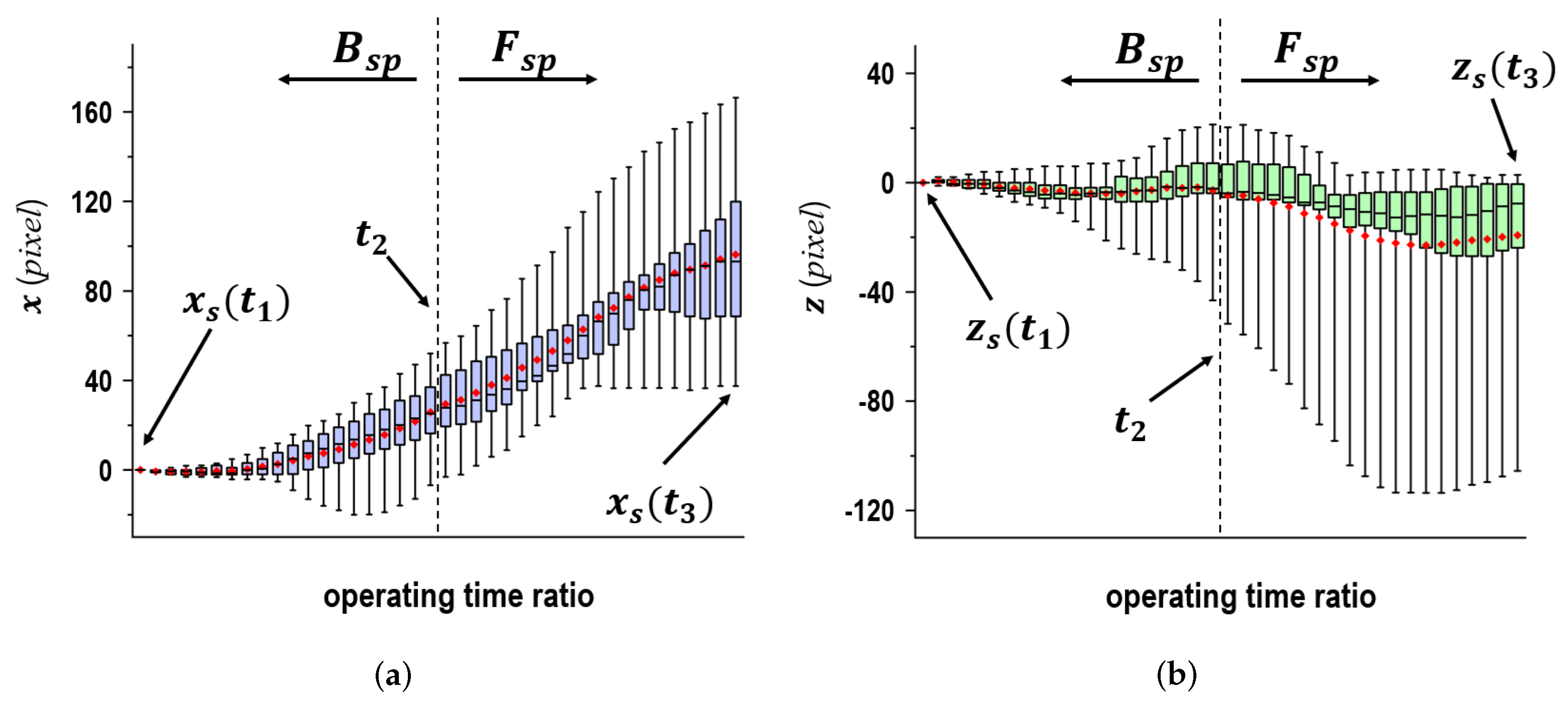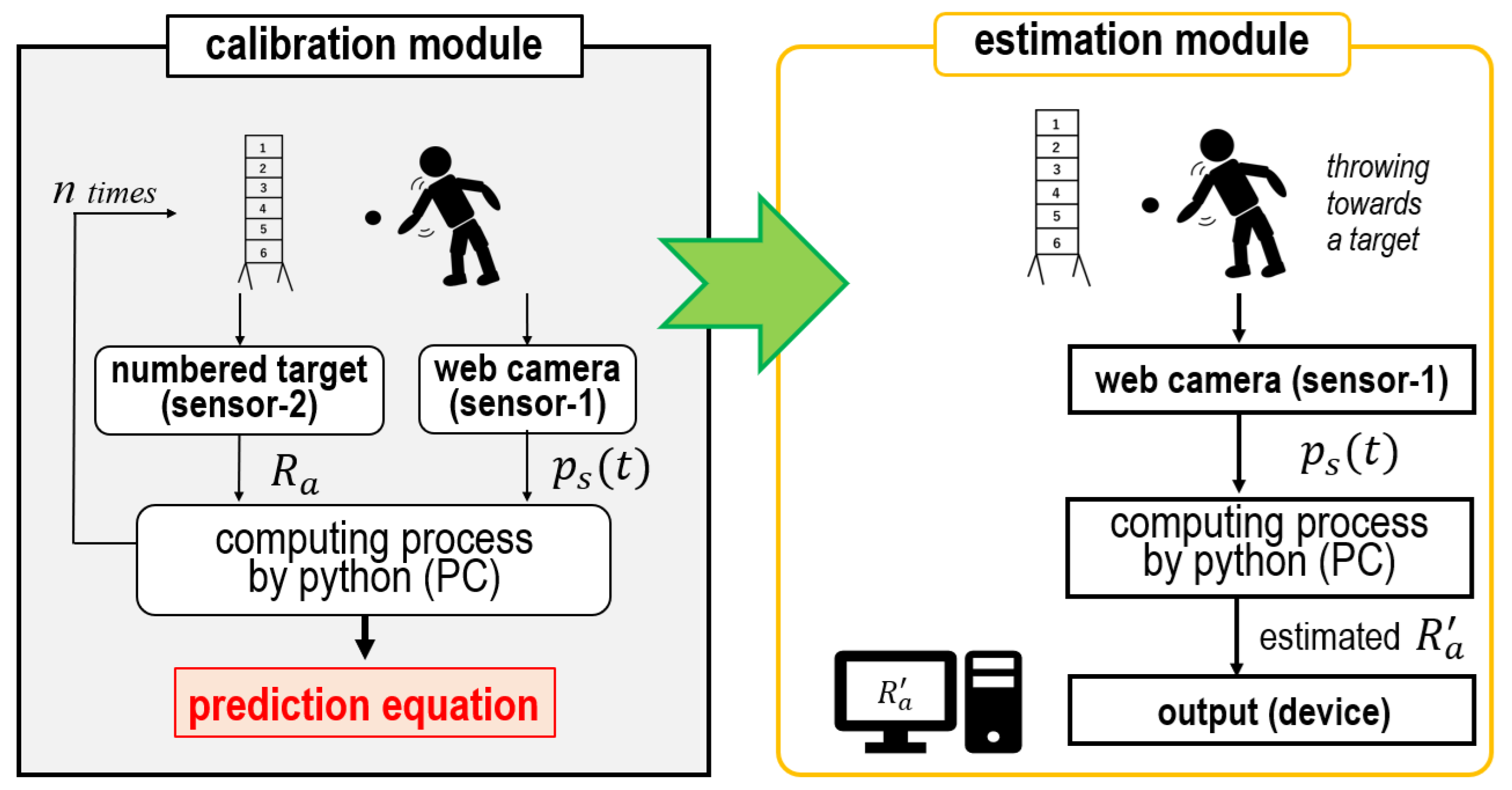Shoulder Movement-Centered Measurement and Estimation Scheme for Underarm-Throwing Motions
Abstract
:1. Introduction
2. Problem Statement
2.1. Considerations of Underarm Throwing
2.2. Problem Definition
- Select an appropriate body part, enabling the estimation of .
- Investigate the relationship between the movements of the selected part and and evaluate its generality.
- Build an estimation model using the obtained relation that is adjusted for individual differences and demonstrate its effectiveness through evaluation tests.
3. Formulation of Underarm Throwing Motion
3.1. Observation of Shoulder Movements
3.2. Definition of Ball-Throwing Motions
3.3. Experimental Settings for Measurement of Underarm Throwing Motion
3.4. Experimental Results for the Measurement of Underarm Throwing Motion
- Have you been joining in recreational activities that involve throwing a ball (such as boccia)?
- Do you find upper extremity movements, including throwing movements, burdensome?
3.5. Model of Underarm-Throwing Motion
3.6. Discussion of Underarm Throwing Motion Model
4. Enhanced Estimation Scheme and Evaluation Results
4.1. Calibration and Estimation Model for Underarm Throwing Motions
4.2. Evaluation Experiments for Calibration and Estimation Model
- Investigating the estimation accuracy after changing the number of balls n thrown in the calibration module
- Performing the evaluation experiments with multiple subjects and evaluating the estimation accuracy based these results.
4.3. Evaluation Results and Discussion
5. Conclusions
Author Contributions
Funding
Institutional Review Board Statement
Informed Consent Statement
Data Availability Statement
Conflicts of Interest
References
- Jarvis, S.; Rainer, P.; Ganesh, S. Fundamental movement proficiency of Welsh primary school children and the influence of the relative age effect on skill performance—Implications for teaching. Education 3-13 2023, 51, 907–918. [Google Scholar] [CrossRef]
- Hulteen, R.M.; True, T.; Kroc, E. Trust the “Process”? When fundamental motor skill scores are reliably unreliable. Meas. Phys. Educ. Exerc. Sci. 2023, 27, 391–402. [Google Scholar] [CrossRef]
- Lawson, C.; Eyre, E.L.J.; Tallis, J.; Duncan, M.J. Fundamental movement skill proficiency among British primary school children: Analysis at a behavioral component level. Percept. Mot. Skills 2021, 128, 625–648. [Google Scholar] [CrossRef]
- Vieira, I.P.; Lobo, P.C.B.; Fisher, J.; Ramirez-Campilo, R.; Pimentel, G.D.; Gentil, P. Effects of high-speed versus traditional resistance training in older adults. Sport. Health A Multidiscip. Approach 2021, 14, 283–291. [Google Scholar] [CrossRef] [PubMed]
- Jacques, C.J.; Labbe, A.; Mercer, C.; Moran, A.; Weldy, J. Rehabilitation of the throwing athlete —How to get them back to sport. Oper. Tech. Sport. Med. 2020, 28, 150737. [Google Scholar]
- Aoyama, J.T.; Maier, P.; Servaes, S.; Serai, S.D.; Ganley, T.J.; Potter, H.G.; Nguyen, J.C. MR imaging of the shoulder in youth baseball players: Anatomy, pathophysiology, and treatment. Clin. Imaging 2019, 57, 99–109. [Google Scholar] [CrossRef]
- Jan, Z.; Abas, M.; Khan, I.; Qazi, M.I.; Jan, Q.M.U. Design and analysis of wrist hand orthosis for carpal tunnel syndrome using additive manufacturing. J. Eng. Res. 2024; in press. [Google Scholar] [CrossRef]
- Popescu, D.; Iacob, M.C.; Tarba, C.; Laptoiu, D.; Cotruţ, C.M. Exploring a novel material and approach in 3D-printed wrist-hand orthoses. J. Manuf. Mater. Process. 2024, 8, 29. [Google Scholar] [CrossRef]
- Bos, R.A.; Haarman, C.J.; Stortelder, T.; Nizamis, K.; Herder, J.L.; Stienen, A.H.A.; Plettenburg, D.H. A structured overview of trends and technologies used in dynamic hand orthoses. J. Neuroeng. Rehabil. 2016, 13, 62. [Google Scholar] [CrossRef]
- Chen, Z.; Min, H.; Wang, D.; Xia, Z.; Sun, F.; Fang, B. A review of myoelectric control for prosthetic hand manipulation. Biomimetics 2023, 8, 328. [Google Scholar] [CrossRef]
- Pascal, W.; Julia, S.; Samuel, R.; Felix, H.; Tamim, A. Designing prosthetic hands with embodied intelligence: The KIT prosthetic hands. Front. Neurorobotics 2022, 16, 815716. [Google Scholar] [CrossRef]
- Dunai, L.; Novak, M.; García Espert, C. Human hand anatomy-based prosthetic hand. Sensors 2021, 21, 137. [Google Scholar] [CrossRef]
- Vertongen, J.; Kamper, D.G.; Smit, G.; Vallery, H. Mechanical aspects of robot hands, active hand orthoses, and prostheses: A comparative review. IEEE/ASME Trans. Mechatronics 2021, 26, 955–965. [Google Scholar] [CrossRef]
- Immaculada, L.-H.; Perez-Gonzalez, A.; Veronica, G.-I. Anthropomorphism index of mobility for artificial hands. Appl. Bionics Biomech. 2019, 2019, 7169034. [Google Scholar]
- Suarez-Iglesias, D.; Carlos, A.P.; Nuria, M.-L.; Villa-Vicente, J.G. Boccia as a rehabilitation intervention for adults with severe mobility limitations due to neuromuscular and other neurological disorders: Feasibility and effects on upper limb impairments. Front. Psychol. 2020, 11, 581. [Google Scholar] [CrossRef]
- Koper, M.; Nadolska, A.; Urbanski, P.; Wilski, M. Relationship between pre-competition mental state and sport result of disabled boccia athletes. Int. J. Environ. Res. Public Health 2020, 17, 8232. [Google Scholar] [CrossRef]
- Suzuki, R.; Onishi, R.; Kasamatsu, K.; Shimomura, Y.; Nitta, O.; Motegi, R.; Tsuchiya, S.; Shida, N.; Takesue, N. Development of boccia robot and its throwing support interface. In Human Interface and the Management of Information. Information in Intelligent Systems; Yamamoto, S., Mori, H., Eds.; Lecture Notes in Computer Science; Springer: Berlin/Heidelberg, Germany, 2019; Volume 11570, pp. 556–567. [Google Scholar]
- Deng, M.; Chen, R.; Song, S.; He, J.; Onishi, R.; Suzuki, R.; Motegi, R.; Takesue, K.; Tsuchiya, S.; Shimomura, Y.; et al. Interface design for boccia robot considering operation characteristic. In HCI International 2019—Late Breaking Papers; Stephanidis, C., Ed.; Lecture Notes in Computer Science; Springer: Berlin/Heidelberg, Germany, 2019; Volume 11786, pp. 382–394. [Google Scholar]
- Gorski, F.; Grohs, A.; Kuczko, W.; Żukowska, M.; Wichniarek, R.; Siwiec, S.; Băilă, D.-I.; Zelenay, M.; Păcurar, R.; Sanfilippo, F. Development and studies of VR-assisted hand therapy using a customized biomechatronic 3D printed orthosis. Electronics 2024, 13, 79. [Google Scholar] [CrossRef]
- Nakayama, J.; Sunagawa, K.; Ogawa, K.; Oka, H. Analysis of a new artificial muscle type dynamic orthosis for wrist joint disease using a three-dimensional motion analyzer. Prog. Rehabil. Med. 2021, 6, 20210043. [Google Scholar] [CrossRef]
- Yamac, G.; Chai, J.J.K.; O’Sullivan, C. Let it go! Point of release prediction for virtual throwing. Comput. Graph. 2023, 110, 11–18. [Google Scholar] [CrossRef]
- Reina, R.; Dominguez-Diez, M.; Urban, T.; Roldan, A. Throwing distance constraints regarding kinematics and accuracy in high-level boccia players. Sci. Sport. 2018, 33, 299–306. [Google Scholar] [CrossRef]
- Maselli, A.; Dhawan, A.; Cesqui, B.; Russo, M.; Lacquaniti, F.; d’Avella, A. Where are you throwing the ball? I better watch your body, Not just your arm! Front. Hum. Neurosci. 2017, 11, 505. [Google Scholar] [CrossRef]
- Hendarto, S.; Doewes, R.I.; Gontara, S.Y.; Manshuralhudlori, M. Gender differences in boccia underhand throw biomechanics. Ibero-Am. J. Exerc. Sport. Psychol. 2023, 18, 228–234. [Google Scholar]
- Angel-Lopez, J.P.; Castellanos-Ruiz, J.; Rojas-Lopez, L.T.; Ramirez-Restrepo, D.; Gomez-Alzate, A.; Orozco-Ocampo, Y.M.; Aguirre-Ospina, C.A.; Hoyos-Restrepo, M.C. Boccia assistant biomechanics: A case study. In Proceedings of the VIII Latin American Conference on Biomedical Engineering and XLII National Conference on Biomedical Engineering, Cancún, México, 2–5 October 2019; González Díaz, C.A., González, C.C., Leber, E.L., Vélez, H.A., Puente, N.P., Flores, D.-L., Andrade, A.O., Galván, H.A., Martínez, F., García, R., et al., Eds.; IFMBE Proceedings. Springer: Berlin/Heidelberg, Germany, 2020; Volume 75, pp. 884–893. [Google Scholar]
- Doewes, R.I.; Nuryadin, I.; Agustiyanta, U.; Adirahma, A.S. Analysis of underhand throwing movement on cerebral palsy athletes. Int. J. Adv. Sci. Technol. 2020, 29, 675–690. [Google Scholar]
- Yokota, H.; Ohshima, S.; Mizuno, N. Information visualisation of optimised underhand throw for cybernetic training. Procedia Eng. 2015, 115, 534–539. [Google Scholar] [CrossRef]
- Ramasamy, Y.; Usman, J.; Razman, R.; Wei, Y.M.; Towler, H.; King, M. A systematic review of the biomechanical studies on shoulder kinematics in overhead sporting motions: Types of analysis and approaches. Appl. Sci. 2023, 13, 9463. [Google Scholar] [CrossRef]
- Trasolini, N.A.; Nicholson, K.F.; Mylott, J.; Bullock, G.S.; Hulburt, T.C.; Waterman, B.R. Biomechanical analysis of the throwing athlete and its impact on return to sport. Arthrosc. Sport. Med. Rehabil. 2022, 4, e83–e91. [Google Scholar] [CrossRef]
- Medina, G.; Bartolozzi, A.R.; Spencer, J.A.; Morgan, C. The thrower’s shoulder. J. Bone Jt. Surg. Rev. 2022, 10, e21.00194. [Google Scholar] [CrossRef]
- Torabi, T.P.; Juul-Kristensen, B.; Dam, M.; Zebis, M.K.; van den Tillaar, R.; Bencke, J. Comparison of shoulder kinematics and muscle activation of female elite handball players with and without pain—An explorative cross-sectional study. Front. Sport. Act. Living 2022, 4, 868263. [Google Scholar] [CrossRef]
- Schwarz, A.; Bhagubai, M.M.C.; Nies, S.H.G.; Held, J.P.O.; Veltink, P.H.; Buurke, J.H.; Luft, A.R. Characterization of stroke-related upper limb motor impairments across various upper limb activities by use of kinematic core set measures. J. Neuroeng. Rehabil. 2022, 19, 2. [Google Scholar] [CrossRef]
- Mick, S.; Segas, E.; Dure, L.; Halgand, C.; Benois-Pineau, J.; Loeb, G.E.; Cattaert, D.; de Rugy, A. Shoulder kinematics plus contextual target information enable control of multiple distal joints of a simulated prosthetic arm and hand. J. Neuroeng. Rehabil. 2021, 18, 3. [Google Scholar] [CrossRef]
- Cross, R. Throwing accuracy. Phys. Educ. 2018, 53, 035021. [Google Scholar] [CrossRef]
- Dupuy, M.A.; Mottet, D.; Ripoll, H. The regulation of release parameters in underarm precision throwing. J. Sport. Sci. 2000, 18, 375–382. [Google Scholar] [CrossRef] [PubMed]
- Braatz, J.H.; Gogia, P.P. The mechanics of pitching. J. Orthop. Sport. Phys. Ther. 1987, 9, 56–69. [Google Scholar] [CrossRef]


















| Subject | Number of Throws | Accuracy (%) |
|---|---|---|
| subject #1 | 20 | 80 |
| subject #2 | 20 | 85 |
| subject #3 | 20 | 70 |
Disclaimer/Publisher’s Note: The statements, opinions and data contained in all publications are solely those of the individual author(s) and contributor(s) and not of MDPI and/or the editor(s). MDPI and/or the editor(s) disclaim responsibility for any injury to people or property resulting from any ideas, methods, instructions or products referred to in the content. |
© 2024 by the authors. Licensee MDPI, Basel, Switzerland. This article is an open access article distributed under the terms and conditions of the Creative Commons Attribution (CC BY) license (https://creativecommons.org/licenses/by/4.0/).
Share and Cite
Lee, G.; Hayakawa, Y.; Watanabe, T.; Bonkobara, Y. Shoulder Movement-Centered Measurement and Estimation Scheme for Underarm-Throwing Motions. Sensors 2024, 24, 2972. https://doi.org/10.3390/s24102972
Lee G, Hayakawa Y, Watanabe T, Bonkobara Y. Shoulder Movement-Centered Measurement and Estimation Scheme for Underarm-Throwing Motions. Sensors. 2024; 24(10):2972. https://doi.org/10.3390/s24102972
Chicago/Turabian StyleLee, Geunho, Yusuke Hayakawa, Takuya Watanabe, and Yasuhiro Bonkobara. 2024. "Shoulder Movement-Centered Measurement and Estimation Scheme for Underarm-Throwing Motions" Sensors 24, no. 10: 2972. https://doi.org/10.3390/s24102972






